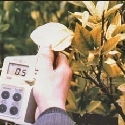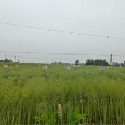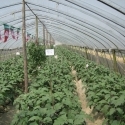04 Jan 2017
4R Nutrient Management for Rhizome Lotus Production in Hubei Province of China

Lotus (Nelumbo nucifera Gaertn. ssp nucifera) is well known for its beautiful flowers, medicinal properties, and edible rhizome and seed in Southeast Asia and Australia, especially in China. According to morphological differentiation and different purpose, Chinese lotus could be classified into three types: rhizome lotus, seed lotus and flower lotus, which were used as food, medicine and ornamentals. Among the three types, rhizome lotus occupies the largest plantation area with the highest yield and economic values, and is mainly planted in south China such as Hubei, Anhui, Jiangsu, Zhejiang provinces along Yangtze River valley. In the lotus planting provinces, Hubei (29°05´–33°20´ N, 108°30´–116°10´ E) ranks first with an average rhizome lotus plantation area of 72,700 ha and an average yield of 16,430 kg/ha over the last 15 years, which accounts for more than 25% of the China’s total rhizome lotus production.
The investigation of Hubei Soil and Fertilizer Institute in recent years showed that one of the main problems in rhizome lotus production in the province is poor nutrients management with the corresponding high risk of environment pollution. Soils in rhizome lotus field usually have higher fertility due to the large amount of nitrogen, phosphorus and/or compound fertilizers application compared with grain crops. The average content of soil organic matter and total N was 27.2 and 2.20 g/kg. Average soil available N, P and K, slow available K, available B and available Zn was 181, 24.4, 134, 731, 0.27 and 0.53 mg/kg, respectively. Unbalanced fertilization was the main factor limiting rhizome lotus yield and quality in Hubei. Average N, P2O5 and K2O fertilization rates from chemical and organic sources were 516, 196 and 172 kg/ha, respectively, with N: P2O5: K2O = 1: 0.38: 0.33, which implied that N and P fertilization rates were high while K fertilization rate was low. Additionally, farmers were not aware of the significance of B and Zn fertilization.
Pot culture experiments showed that, the content of reducing sugar, total soluble sugar and starch from appropriate K treatment was higher than K omission treatment by 35.9%, 7.2% and 8.1%, respectively. The content of starch from appropriate N treatment was higher than N omission treatment and 2 times appropriate N treatment by 9.1% and 17.0%, respectively. Field experiments indicated that, yield limiting factors for rhizome lotus were ranked as N>K>P>Zn>B in Hubei province. N, P and K uptake for 1,000 kg (FW) rhizome production was 3.27, 0.63 and 5.02 kg respectively. An average fertilization rate of N 360 kg/ha, P2O5 90 kg/ha, and K2O 270 kg/ha is recommended for the rhizome lotus in Hubei along with Zn and B where soil test result is low. Rational N fertilizer assignment was suggested to be: 40-60% for basal dressing +20% top-dressing in early June + 20-40% top-dressing in late June, while 2 rational K fertilizer assignments were proposed, which was 50% for basal dressing +20% top-dressing in early June + 30% top-dressing in late June or early July, or 70% for basal dressing +30% top-dressing in late June or early July, according to soil testing.




